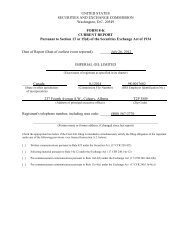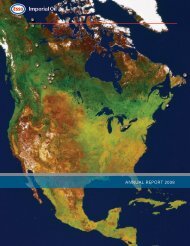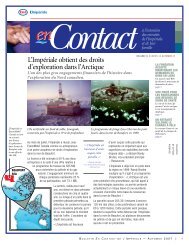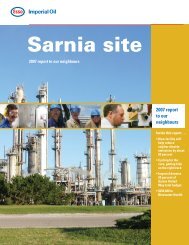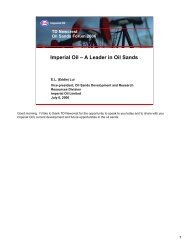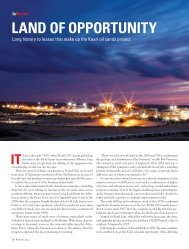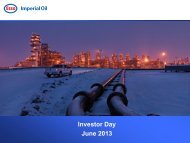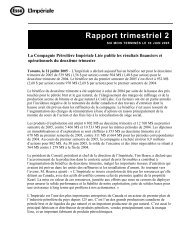FORM 10-K IMPERIAL OIL LIMITED
FORM 10-K IMPERIAL OIL LIMITED
FORM 10-K IMPERIAL OIL LIMITED
Create successful ePaper yourself
Turn your PDF publications into a flip-book with our unique Google optimized e-Paper software.
Petroleum products<br />
The downstream continues to experience ongoing volatility in industry margins. Refining margins are the<br />
difference between what a refinery pays for its raw materials (primarily crude oil) and the wholesale market<br />
prices for the range of products produced (primarily gasoline, diesel fuel, heating oil, jet fuel and fuel oil).<br />
Crude oil and many products are widely traded with published international prices. Prices for those<br />
commodities are determined by the marketplace, often an international marketplace, and are impacted by<br />
many factors, including global and regional supply/demand balances, inventory levels, refinery operations,<br />
import/export balances, seasonality and weather. Canadian wholesale prices in particular are largely<br />
determined by wholesale prices in adjacent U.S. regions. These prices and factors are continually<br />
monitored and provide input to operating decisions about which raw materials to buy, facilities to operate<br />
and products to make. However, there are no reliable indicators of future market factors that accurately<br />
predict changes in margins from period to period.<br />
The Company's downstream strategies are to provide customers with quality service at the lowest total<br />
cost offer, have the lowest unit costs amongst the Company’s competitors, ensure efficient and effective<br />
use of capital and capitalize on integration with the Company's other businesses. The Company owns and<br />
operates four refineries in Canada with distillation capacity of 502,000 barrels a day and lubricant manufacturing<br />
capacity of 9,000 barrels a day. The Company’s fuels marketing business includes retail operations<br />
across Canada serving customers through about 2,000 Esso-branded service stations, of which about 720<br />
are Company owned or leased, and wholesale and industrial operations through a network of 30 distribution<br />
terminals.<br />
Chemicals<br />
Although the current business environment is favourable, the North American petrochemical industry<br />
is cyclical. The Company’s strategy for its chemicals business is to reduce costs and maximize value by<br />
continuing to increase the integration of its chemicals plants at Sarnia and Dartmouth with the refineries.<br />
The Company also benefits from its integration within ExxonMobil’s North American chemicals businesses,<br />
enabling the Company to maintain a leadership position in its key market segments.<br />
Results of operations<br />
Net income in 2004 was $2,052 million or $5.74 a share – the best year on record – compared with<br />
$1,705 million or $4.58 a share in 2003 (2002 – $1,214 million or $3.20 a share). Higher realizations for<br />
crude oil, stronger industry refining and petrochemical margins, and higher volumes of Syncrude production,<br />
natural gas and petroleum products contributed positively to net income, partly offset by lower marketing<br />
margins. Compared with 2003, these favourable operating results were partly offset by the combined<br />
negative effects of a higher Canadian dollar on resource and product prices of about $260 million, the<br />
absence of favourable foreign exchange effects on the Company’s U.S. dollar denominated debt of about<br />
$1<strong>10</strong> million, and lower benefits from tax matters of about $<strong>10</strong>0 million.<br />
Total revenues were $22.5 billion, up about 17 percent from 2003.<br />
Natural Resources<br />
Net income from natural resources was a record $1,487 million, up from $1,143 million in 2003 (2002 –<br />
$1,042 million). The positive earnings effects of improved realizations for crude oil and natural gas,<br />
combined with higher Syncrude, natural gas and natural gas liquids (NGLs) volumes were partly offset by<br />
lower Cold Lake bitumen production, lower benefits from tax matters and the negative effects of a higher<br />
Canadian dollar.<br />
Resource revenues were $6.6 billion, up from $5.6 billion in 2003 (2002 – $4.9 billion). The main reasons<br />
for the increase were higher prices for crude oil and increased natural gas and Syncrude volumes.<br />
Financial statistics<br />
2004 2003 2002 2001 2000<br />
(millions)<br />
Net income ....................................................... $1,487 $1,143 $1,042 $ 941 $1,165<br />
Revenues ......................................................... 6,625 5,648 4,894 5,321 5,900<br />
U.S. dollar world oil prices were considerably higher in 2004 than in the previous year. The annual<br />
average price of Brent crude oil, the most actively traded North Sea crude and a common benchmark of<br />
world oil markets, was $38 (U.S.) a barrel in 2004, a more than 30 percent increase over the average price<br />
of $29 in 2003 (2002 – $25).<br />
However, increases in the Company’s Canadian dollar realizations for conventional crude oil and Cold<br />
Lake bitumen were dampened by the effects of a higher Canadian dollar. Average realizations for conventional<br />
crude oil during the year were $48.96 (Cdn) a barrel, an increase of 22 percent from that of<br />
$40.<strong>10</strong> in 2003 (2002 – $36.81).<br />
17



